Intel Mobile Penryn Benchmarked: Battery Life Improves Again
by Anand Lal Shimpi on January 7, 2008 12:00 AM EST- Posted in
- CPUs
Increasing Battery Life: It’s the Centrino Way
Intel sent us two Dell Latitude D630 notebooks, identically configured, with one variable: the CPU. In one D630, we had a Core 2 Duo T7800, which is a Merom based chip running at 2.6GHz with an 800MHz FSB and a 4MB L2 cache. The other D630 came equipped with a new 45nm Core 2 Duo T9500, also running at 2.6GHz/800MHz but with a larger 6MB L2 cache.
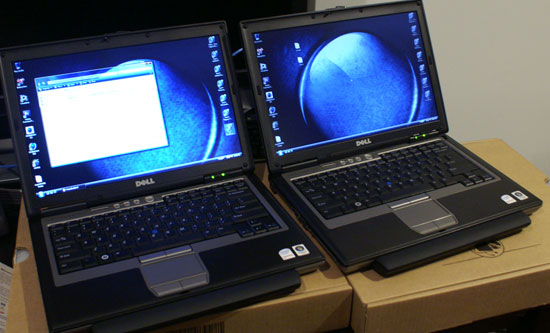
The CPU-Z shots will show that our T9500 CPU ran at 1.15V instead of the 1.225V of the T7800; a reduction in voltage translates directly into a reduction in power consumption of course, meaning longer battery life in a notebook. The question we had was: how much?
Merom:
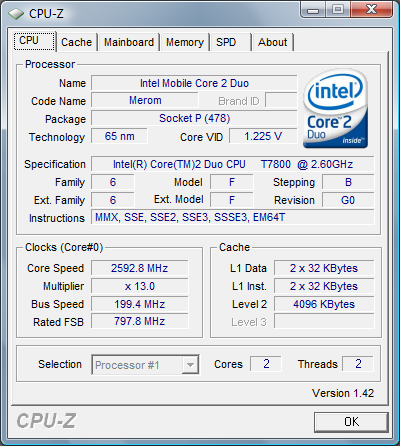
Penryn:

While the CPU is one of the single most power hungry components in a notebook, there are other power hogs as well. The display being one of the most obvious, but other components like the memory, hard drive, chipset and integrated graphics all contribute to the generally mediocre battery life you find in modern day notebooks. All of these power hungry components eat away at that stored energy, so how much could an evolutionary reduction in power actually bring?
To find out if we turned to MobileMark 2007, the latest battery life measurement tool from BAPCo. The MobileMark 2007 suite consists of three individual benchmarks: the Productivity 2007 test, the Reader 2007 test and the DVD playback test.
The Productivity 2007 test mimics what happens in the SYSMark 2007 Productivity test, the only difference being that MobileMark focuses on how long the battery will last, not how fast the system can perform.
We configured both systems identically, LCD brightness was set at three levels down from the maximum and Vista power management settings were set to balanced. To no one’s surprise, the Core 2 Duo T9500 managed to outlast the T7800; it was the margin of victory however that was most surprising.
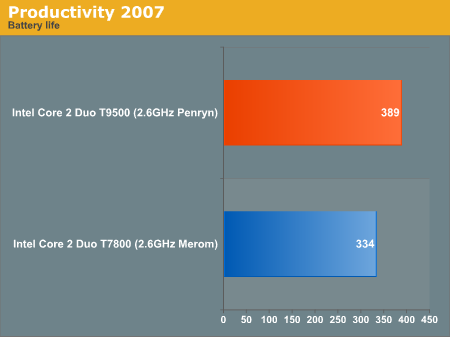
The T9500 lasted an extra 55 minutes, or an increase of almost 16.5% in battery life. We were concerned that the Productivity test over emphasized the impact of Penryn on battery life, so we turned to the other tests in MobileMark.
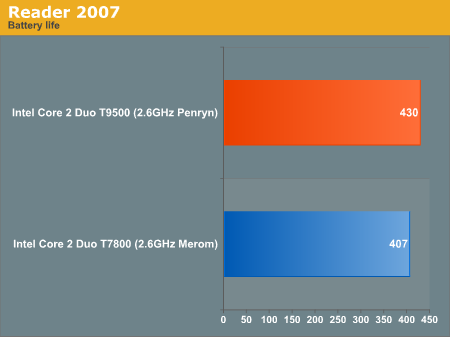
The Reader 2007 test is mostly idle time, simulating a user reading through documents on a notebook. Despite the very light load, battery life went up 5.6% or a total of 23 minutes on the Penryn system compared to the older Merom based T7800. While not nearly as dramatic as the Productivity 2007 test, the Reader benchmark shows significant improvement especially when you take into account that the only change here is the processor.
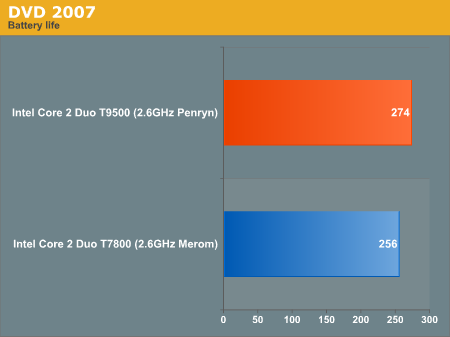
The DVD playback benchmark measures battery life while, you guessed it, playing back a DVD. While we don’t even want to begin to think of what battery life would be like playing back a HD-DVD or Blu-ray movie, regular DVDs are still quite manageable. The move to 45nm gave us an extra 18 minutes of battery life when playing back a DVD, an increase of 7%.
While the Productivity results may be a bit extreme, we believe it would be safe to say that the mobile version of Penryn can easily improve battery life on the order of 5 - 10% over an identically configured Merom/Santa Rosa system. Under very specific cases, especially if you’re looking at applications where Penryn is significantly faster than Merom (e.g. SSE4 optimized apps), battery life can improve even more dramatically
Herein lies the strength of these yearly Centrino updates; these increases in battery life will come at no additional cost to the end user. Dell will begin shipping its D630 notebooks with these Core 2 Duo T9500 processors starting in February, at no price premium compared to its current D630 lineup. The T9500 will simply replace the T7800 as the 2.6GHz processor option.










18 Comments
View All Comments
metacircular - Friday, January 11, 2008 - link
Thanks for the review, but could the reviewers comment on the temperature differences between the two processors? I'm assuming lower voltage will result in less heat, but it would be nice to see some numbers.legoman666 - Thursday, January 10, 2008 - link
It's a shame about that DAT not really being useful. It seems like their ideas were hampered by the fact that applications always bounce from 1 core to another. Looks/sounds like a good idea though.Jussi - Wednesday, January 9, 2008 - link
Thanks for an interesting article, Penryn it seems like a nice, although not essential refresh.I'd like to nitpick the SSE4 performance numbers. You state that in case of Virtualdub "Penryn would offer a greater than 40% increase in performance". I find this to be incorrect.
Let performance or speed (v) be defined as v = work unit / time. v1 is the speed of Merom and v2 is the speed of Penryn. Comparing Penryn to Merom = v2/v1 => t1/t2. Using your numbers 47.3s / 28.2s = 1.677 => 68% better performance.
It would be correct to state that using Penryn takes about 40% less time to do the job, but that is not what the article states.
puffpio - Tuesday, January 8, 2008 - link
Could I just swap chips out?channelv - Wednesday, January 9, 2008 - link
Yup, the D630 uses the 965 chipset (Santa Rosa). But you'd better wait for a BIOS update from Dell first before you think about putting a Penryn in there - I'd expect those to roll out almost any day now, but by Feb. for sure.Mr Alpha - Tuesday, January 8, 2008 - link
Have I understood it correctly, that you are comparing the SSE4 version of DivX on Penryn with the same SSE4 version of DivX on Merom? Shouldn't you be comparing the SSE4 version of DivX on Penryn to the SSE3 version of DivX on Merom?mi1400 - Tuesday, January 8, 2008 - link
Electric surges drain battery faster. When a device bulb, motor etc starts a peak is occured in load and then load comes to a lesser and steady value. Intel Dynamic Acceleration may result in same for battery.Mgz - Monday, January 7, 2008 - link
how about the Deep Power Down (C6) stage that penryn brings ? Any test on this feature?coolme - Monday, January 7, 2008 - link
Good review, but just to note.Merom (part of santa rosa) supports Intel Dynamic Acceleration, (although T7xxx series only) and since you guys weren't aware of that, the cinebench benchmark (and other benchmarks) with the T7800 might have a skewed score.
duploxxx - Monday, January 7, 2008 - link
Nice to see that the t9xxx series will step up the performance again and battery life. Altough we can already say that Intel dominated this part of the mobile market for a long time with t7xxx it is now sure that it will increase that even more.what i really want to no is what about low end and midstream, how good are these t2xxx - t5xxx - t7xxx series compared to each other and what happens when you put a rather cheap turion class next to those t2 and t5 series.
@anand i think you would hit a readers max out of such a review, but then again it would take a lot of time and effort to get a nice compare with equal hardware parts and price....